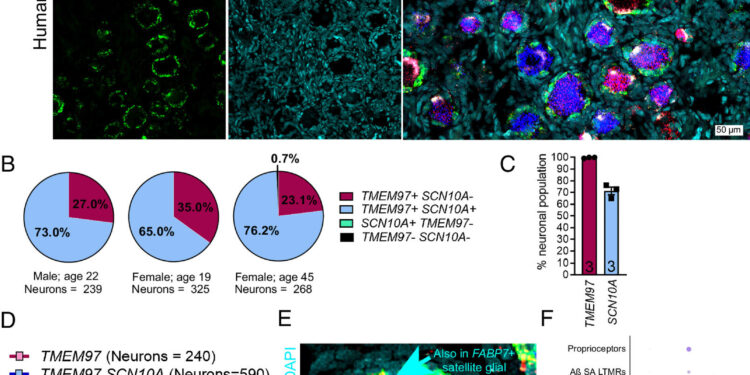The TMEM97 gene is expressed in human DRG. Credit: Proceedings of the National Academy of Sciences (2023). DOI: 10.1073/pnas.2306090120
A new approach to treating neuropathic pain is taking a big step forward thanks to researchers at the University of Texas at Austin.
Among the most difficult types of pain to relieve is neuropathic pain, pain typically caused by nerve damage in various body tissues, including the skin, muscles, and joints. Patients may experience sensations such as electric shocks, tingling, burning, or stabbing sensations.
Diabetes, multiple sclerosis, chemotherapy drugs, injuries and amputations have all been associated with neuropathic pain, which is often chronic, sometimes persistent, and affects millions of people worldwide. Most available painkillers are only moderately effective in treating this type of pain and often carry serious side effects, as well as the risk of addiction.
Now, researchers from UT Austin, the University of Texas at Dallas and the University of Miami have identified a molecule that reduces hypersensitivity in mouse tests by binding to a protein whose they showed that it was involved in neuropathic pain.
The results appear in the journal Proceedings of the National Academy of Sciences.
“We found that it was an effective pain reliever and that its effects lasted quite a long time,” said Stephen Martin, the June and J. Virgil Wagoner Regents Chair in Chemistry at the University of Texas at Austin and co-author corresponding to the article. . “When we tested it in different models, for example diabetic neuropathy and chemotherapy-induced neuropathy, we found that this compound had an incredible beneficial effect.”
The new compound, called FEM-1689, does not engage opioid receptors in the body, making it a possible alternative to existing addiction-linked painkillers. In addition to reducing sensitivity, the compound may help regulate the integrated stress response (ISR), a cellular signaling network that helps the body respond to injury and disease.
When properly regulated, ISR restores balance and promotes healing. When it goes wrong, ISR can contribute to diseases such as cancer, diabetes and metabolic disorders.
“Our goal is to turn this compound into a drug that can be used to treat chronic pain without the dangers of opioids,” Martin said. “Neuropathic pain is often a debilitating disease that can affect people throughout their lives, and we need treatment that is well tolerated and effective.”
“This work is the culmination of a wonderful five-year collaboration with our colleagues at UT Austin and is an excellent example of academic drug discovery advancing the field of non-opioid pain treatments,” said Theodore Price , professor of neuroscience at the University of Toronto. University of Texas at Dallas and co-corresponding author of the article.
More information:
Muhammad Saad Yousuf et al, the highly specific σ 2 ligand R/TMEM97 FEM-1689 relieves neuropathic pain and inhibits the integrated stress response, Proceedings of the National Academy of Sciences (2023). DOI: 10.1073/pnas.2306090120
Provided by the University of Texas at Austin
Quote: Researchers discover potential non-opioid treatment for chronic pain (January 30, 2024) retrieved January 30, 2024 from
This document is subject to copyright. Except for fair use for private study or research purposes, no part may be reproduced without written permission. The content is provided for information only.



